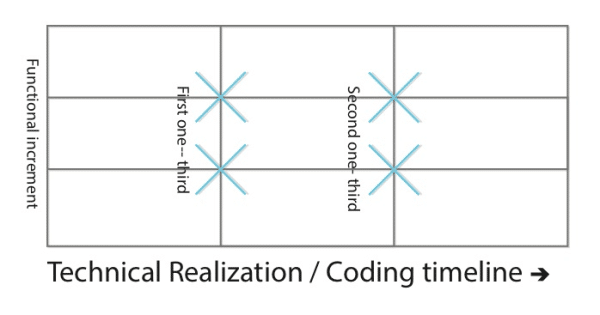Software development has evolved over the past several decades perfecting itself each time, to become more and more scientific in its approach and predictability. However, there is a strong artistic side to software development that gets manifested in the areas of design and architecture.
 For the first one-third of the development, the focus is always on getting the functional understanding of the requirements correct. Therefore, sharing the test scenarios and giving inputs for the test automation should essentially be the crux of the discussions. Any discrepancies, gaps in the requirements must be closed at this stage of discussion. The test preparation aspects that should be under consideration at this juncture include smoke test scenarios, acceptance test scenarios, integration test scenarios and automation test needs.
For the second and final one-third of the development, the auxiliary aspects of test including the load, performance, stress and security tests preparation could be the primary focus. The usability tests could also be a good topic for discussion as most often the UI wiring would appear in the later part of the development focus.
A test thus evolved and prepared in close interaction with the technical realization phase, works in perfect synchronization, balancing the composition of development and test without stressing out one another. Software products and applications tested using the rule of thirds concept would strike a perfect balance between science and art and produce high quality software.
[contact-form-7 id="21032" title="Breaking the Enigma called Scrum Testing"]
For the first one-third of the development, the focus is always on getting the functional understanding of the requirements correct. Therefore, sharing the test scenarios and giving inputs for the test automation should essentially be the crux of the discussions. Any discrepancies, gaps in the requirements must be closed at this stage of discussion. The test preparation aspects that should be under consideration at this juncture include smoke test scenarios, acceptance test scenarios, integration test scenarios and automation test needs.
For the second and final one-third of the development, the auxiliary aspects of test including the load, performance, stress and security tests preparation could be the primary focus. The usability tests could also be a good topic for discussion as most often the UI wiring would appear in the later part of the development focus.
A test thus evolved and prepared in close interaction with the technical realization phase, works in perfect synchronization, balancing the composition of development and test without stressing out one another. Software products and applications tested using the rule of thirds concept would strike a perfect balance between science and art and produce high quality software.
[contact-form-7 id="21032" title="Breaking the Enigma called Scrum Testing"]
Written by
Jyothsna Madhunapantula, SVP, Delivery & Operational Excellence
Jyothsna is an accomplished technology professional with proven expertise in design, development, and delivery of enterprise-class software products for global businesses.
Our Ideas
Explore More Blogs
Contact



